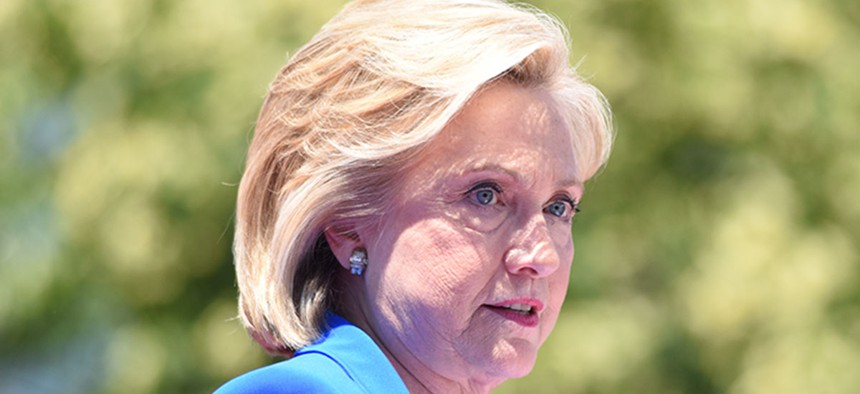
a katz / Shutterstock.com
State Releases Another Trove of Hillary Clinton Emails
The sixth such release, of more than 7,000 pages, includes references to Lady Gaga, Ben Affleck, monkey butts, and emojis.
The State Department released more than 7,000 pages of Hillary Clinton’s emails Wednesday afternoon, a move that will provide more insight into Clinton’s four-year tenure as secretary of State but is unlikely to include any bombshells.
The new trove of emails—the sixth such release from State—came largely from messages that Clinton sent or received in 2011 and 2012, the State Department said.
Clinton turned over more than 55,000 pages of emails to the State Department at the end of last year. Her use of a private email address, hosted on a server at the Clintons’ Chappaqua, New York home, has made headlines since it was first revealed in a New York Times story this spring.
But unlike past monthly releases, Clinton is in a far different position today than she was even a month ago. Comments from House Majority Leader Kevin McCarthy at the end of September about how the Benghazi Select Committee had helped bring down Clinton’s poll numbers allowed her campaign to successfully argue that Republicans were politicizing the Benghazi attacks—and her email use—as a way to sabotage her candidacy. Last week, Clinton appeared before the committee for 11 hours of testimony on what happened surrounding the 2012 attacks, including a great deal of focus on her email account.
The staggered release of all Clinton’s emails—coming in batches at the end of each month through January—had contributed to the continued headlines over her email use, a dynamic that was bringing down Clinton’s poll numbers and contributing to dropping favorability ratings.
Past releases have given some insight into Clinton’s temperament at State and the way the department functioned, but turned up almost no controversial or substantively new information.
The latest emails do provide glimpses of the internal discussion of the proposed Keystone XL oil-sands pipeline, a project that Clinton said in 2010 she was “inclined” to approve but now opposes.
In one Feb. 9, 2012 message, Michael Hammer, then a public affairs official, emailed a suite of senior aides with press coverage of a State Department inspector general report that did not substantiate charges of conflicts of interest in the department’s review. The message says, “overall a good day,” as of 8 p.m. Cheryl Mills, who was Clinton’s chief of staff, forwarded the message to her.
A separate message earlier in the day from Hammer to Mills and others calls the press stories “real solid.” But it notes the portrayal of the report—which called for improvements to State’s review procedures—by Democratic lawmakers opposed to the pipeline. It was also forwarded to Clinton.
Various other messages forwarded to Clinton by top aides contain press coverage of events in the years-long Keystone saga, some with notes about the stories.
There are a few emails the White House doesn’t want reporters and opposition researchers scouring Clinton’s correspondence to see, according to a report Friday in The New York Times. But that’s not, officials say, because they’re worried about the emails’ content: Rather, they’re trying to prevent a “handful” of notes between President Obama and Clinton from being released based on “longstanding precedent invoked by presidents of both parties to keep presidential communications confidential” while they’re still in office. White House officials moved to stop the emails’ release after the State Department found and forwarded them.
Elsewhere, one email making the rounds Friday afternoon has this colorful subject line: “AXELROD AND THE MONKEY BUTT.”
It’s a Dec. 14, 2011 message to Clinton from longtime ally Sidney Blumenthal, and it finds Blumenthal complaining about the reelection-campaign strategy of Obama’s political team, specifically top adviser David Axelrod.
Blumenthal, writing in all capital letters, complains that Axelrod had attacked former House Speaker Newt Gingrich (then a White House candidate) in the press, arguing instead that Obama’s team should talk up the strength of Gingrich’s candidacy as a way to hurt Mitt Romney.
Blumenthal flags these comments by Axelrod to reporters, via ABC News: “Axelrod said the former House speaker’s climb to the top of the pack will further expose his least flattering personal and professional qualities. ‘Just remember, the higher a monkey climbs on a pole, the more you can see his butt,’ Axelrod said, citing a piece of political wisdom he said he learned from a Chicago alderman.”
Blumenthal calls it “political malpractice” and adds that Obama’s team instead should aim to “lift Newt, undermine Romney, anything to prevent his nomination, create wedges within GOP primary.” It adds: “Why is the Obama team helping Romney try to bring down Newt!?!?!”
Clinton replied three days later with this: “Who knows????”
Other emails show Clinton’s correspondence—or planned correspondence—with some high-profile celebrities.
One August 2011 message among aides that Mills forwarded to Clinton was about singer Lady Gaga coming to Clinton’s defense against criticism of her wardrobe. “You know, I think Hillary Clinton has more things to worry about than her hemline,” Gaga said on the TV talk show The View.
A few days later, Clinton forwarded the note to several aides and asked: “Can you get an address for her so I can write a note?”
Another bit of correspondence shows Clinton in contact with Ben Affleck, oft-present in Washington because of his advocacy work, who actually had her direct email address.
In April 2012, the Batman emailed Clinton an advance copy of a report from his Eastern Congo Initiative, which—among other goals—seeks to “drive policy change that increases United States government engagement in Congo.” Subsequent messages between Clinton and her aides—touched off by a request from Clinton, who said she’d “like to respond to Ben Affleck”—show them discussing a draft of her reply. But alas, the draft itself is redacted.
Another exchange is reminiscent of previously released messages in which Clinton grapples with various aspects of State technology. In it, Clinton seeks to learn how to use emojis on her Blackberry. “Here’s my question: on this new berry can I get smiley faces?” she asks aide Philippe Reines.
“For email, no, I don’t think so—you need to type them out manually,” he wrote back. “For text messaging, the chart might be there in the lower right, next to where you type the message.”
(Image via a katz / Shutterstock.com )






